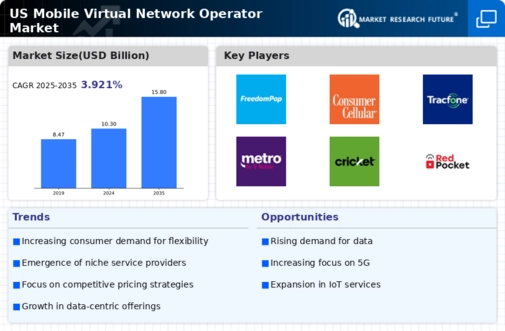The mobile virtual-network-operator market in the US is characterized by a dynamic competitive landscape, driven by innovation, customer-centric strategies, and the increasing demand for flexible mobile solutions. Key players such as TracFone Wireless (US), Mint Mobile (US), and Google Fi (US) are actively shaping the market through distinct operational focuses. TracFone Wireless (US) emphasizes affordability and accessibility, targeting budget-conscious consumers with a range of prepaid plans. Mint Mobile (US), on the other hand, leverages a unique subscription model that encourages long-term customer loyalty, while Google Fi (US) integrates advanced technology and seamless connectivity to attract tech-savvy users. Collectively, these strategies contribute to a moderately fragmented market, where differentiation is increasingly based on service quality and customer experience rather than solely on pricing.
In terms of business tactics, companies are increasingly localizing their operations and optimizing supply chains to enhance service delivery. The competitive structure remains moderately fragmented, with numerous players vying for market share. This fragmentation allows for diverse offerings, catering to various consumer segments. The collective influence of these key players fosters a competitive environment where innovation and customer engagement are paramount, driving the evolution of service offerings and operational efficiencies.
In October 2025, Mint Mobile (US) announced a strategic partnership with a leading tech firm to enhance its network infrastructure. This collaboration aims to improve service reliability and expand coverage, which is crucial in a market where customer expectations for connectivity are continually rising. The strategic importance of this partnership lies in its potential to solidify Mint Mobile's position as a reliable service provider, thereby attracting new customers and retaining existing ones.
In September 2025, Google Fi (US) launched a new AI-driven customer support system designed to streamline user interactions and resolve issues more efficiently. This initiative reflects a broader trend towards digital transformation within the industry, as companies seek to leverage technology to enhance customer satisfaction. The significance of this move is underscored by the growing consumer preference for responsive and effective support, which could lead to increased customer loyalty and brand advocacy.
In August 2025, TracFone Wireless (US) expanded its service offerings by introducing a new tier of plans that include international calling options. This strategic move is indicative of the company's intent to cater to a diverse customer base, particularly among immigrant communities who require affordable international communication solutions. By broadening its service portfolio, TracFone Wireless (US) positions itself to capture a larger share of the market, appealing to consumers seeking value and flexibility.
As of November 2025, current trends in the mobile virtual-network-operator market are increasingly defined by digitalization, sustainability, and the integration of AI technologies. Strategic alliances are becoming more prevalent, as companies recognize the need to collaborate to enhance service offerings and operational efficiencies. Looking ahead, competitive differentiation is likely to evolve, shifting from price-based competition to a focus on innovation, technology integration, and supply chain reliability. This transition suggests that companies that prioritize these aspects will be better positioned to thrive in an increasingly competitive landscape.

















Leave a Comment